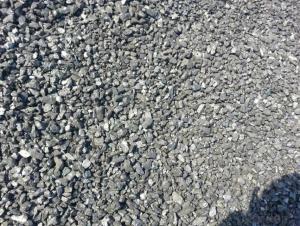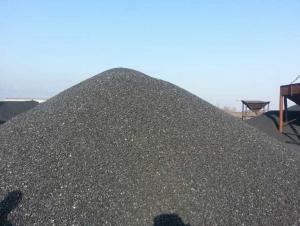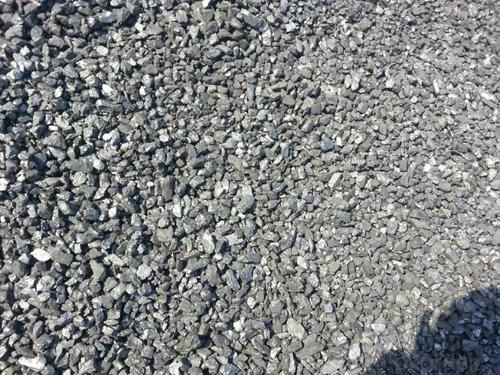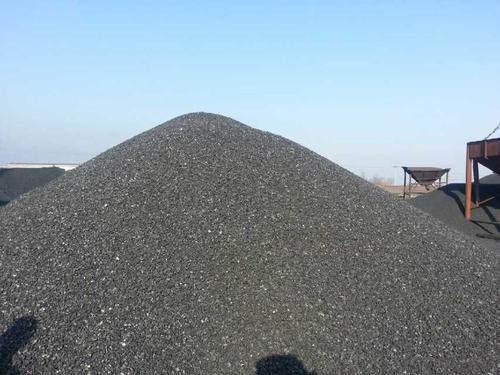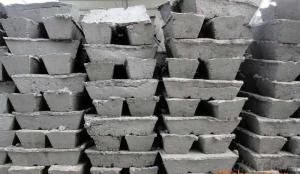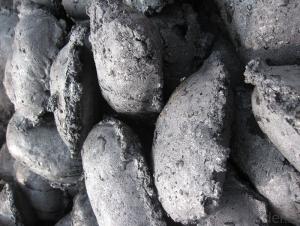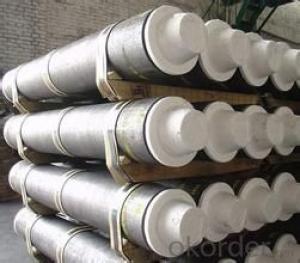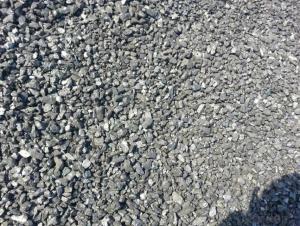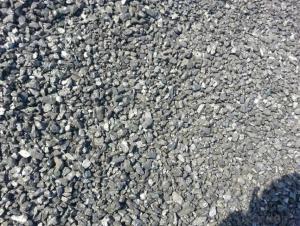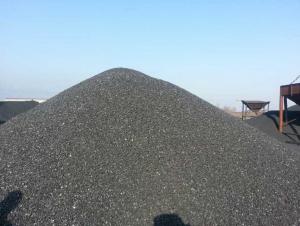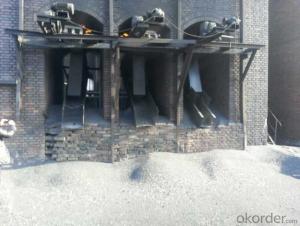Recarburizer FC90-95 with stable quality
- Loading Port:
- Tianjin
- Payment Terms:
- TT OR LC
- Min Order Qty:
- 20 m.t.
- Supply Capability:
- 3000 m.t./month
OKorder Service Pledge
OKorder Financial Service
You Might Also Like
Packaging & Delivery
25kgs/50kgs/1ton per bag or as buyer's request
Specifications
Calcined Anthracite
Fixed carbon: 90%-95%
S: 0.5% max
Size: 0-3. 3-5.3-15 or as request
It used the high quality anthracite as raw materials through high temperature calcined at over 2000 by the DC electric calciner with results in eliminating the moisture and volatile matter from anthracite efficiently, improving the density and the electric conductivity and strengthening the mechanical strength and anti-oxidation. It has good characteristics with low ash, low resistvity, low sulphur, high carbon and high density. It is the best material for high quality carbon products.
Advantage and competitive of caclined anthracite:
1. strong supply capability
2. fast transportation
3. lower and reasonable price for your reference
4.low sulphur, low ash
5.fixed carbon:95% -90%
6..sulphur:lower than 0.3%
General Specification of Calcined Anthracite:
| FC | 95 | 94 | 93 | 92 | 90 |
| ASH | 4 | 5 | 6 | 6.5 | 8.5 |
| V.M. | 1 | 1 | 1 | 1.5 | 1.5 |
| S | 0.3 | 0.3 | 0.3 | 0.35 | 0.35 |
| MOISTURE | 0.5 | 0.5 | 0.5 | 0.5 | 0.5 |
Pictures
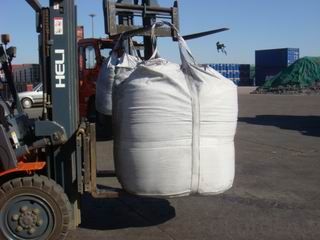
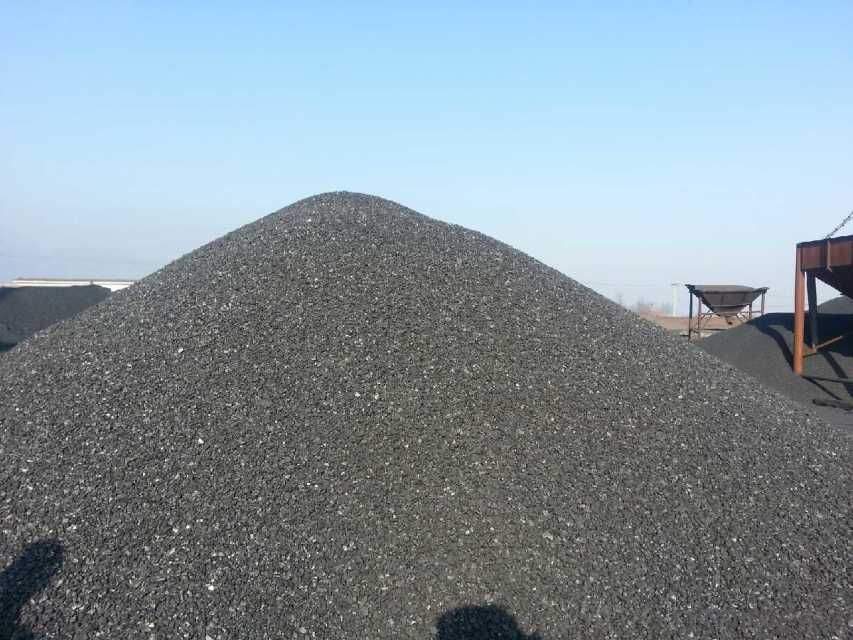
- Q: What is the greenhouse effect of carbon dioxide?
- The greenhouse effect of carbon dioxide refers to the process by which carbon dioxide and other greenhouse gases trap heat in the Earth's atmosphere, leading to a gradual increase in global temperatures.
- Q: What are the effects of carbon emissions on the stability of volcanic regions?
- The stability of volcanic regions can be influenced by both direct and indirect effects of carbon emissions. At first glance, the direct impact of carbon emissions on volcanic areas seems relatively insignificant. Volcanic eruptions naturally release carbon dioxide (CO2), so the additional emissions from human activities may not have a significant individual effect on the stability of volcanic regions. However, the increased levels of carbon dioxide in the atmosphere can contribute to climate change, which can indirectly affect volcanic activity. Indirectly, the stability of volcanic regions can be affected by climate change resulting from carbon emissions. The rising global temperatures caused by climate change can lead to the melting of glaciers and ice caps. This, in turn, increases the amount of water on the Earth's surface. The additional weight of water in volcanic areas can potentially add pressure to magma chambers and trigger volcanic activity. Moreover, the increased water levels can result in higher levels of rainfall, which increases the risk of landslides and erosion in volcanic regions, potentially destabilizing the area. Additionally, climate change can alter precipitation patterns and create drought conditions, impacting the hydrological cycle. These changes can affect the availability of water for volcanic regions, ultimately influencing their stability. Volcanoes require water for the production of steam and pressure that can lead to eruptions. If there is a lack of water due to prolonged drought conditions, volcanic activity may decrease. However, unpredictable rainfall patterns can result in an excess of water, leading to an increased risk of flash floods and landslides that can destabilize volcanic areas. It is important to acknowledge that the effects of carbon emissions on the stability of volcanic regions are intricate and can vary based on factors such as local geology, volcanic activity, and climate conditions. Although carbon emissions may not directly cause volcanic eruptions, they can contribute to changes in climate patterns that can indirectly impact the stability of volcanic systems. Further research and monitoring are necessary to fully comprehend and quantify these effects.
- Q: What is carbon fixation in biology?
- Carbon fixation in biology refers to the process by which carbon dioxide (CO2) from the atmosphere is converted into organic compounds by living organisms. It is a crucial step in the global carbon cycle and is primarily carried out by autotrophic organisms, such as plants, algae, and certain bacteria. During carbon fixation, the enzyme RuBisCO (ribulose-1,5-bisphosphate carboxylase/oxygenase) catalyzes the reaction between CO2 and a five-carbon sugar molecule called ribulose bisphosphate (RuBP). This reaction produces two molecules of a three-carbon compound called 3-phosphoglycerate (3-PGA). This initial step is known as the Calvin cycle or C3 photosynthesis. In plants, the 3-PGA molecules are then converted into other organic compounds, such as sugars, starches, and cellulose, through a series of enzymatic reactions. These organic compounds serve as building blocks for the plant's growth and development. Carbon fixation plays a critical role in maintaining a balance of atmospheric CO2 levels and is a key process in regulating climate change. It allows for the transfer of carbon from the atmosphere into the biosphere, ultimately reducing the concentration of greenhouse gases and mitigating the effects of global warming. Moreover, carbon fixation is essential for sustaining life on Earth as it provides the basis for food chains and supports the growth of other organisms. Heterotrophs, including animals and humans, depend on the organic compounds produced by autotrophs through carbon fixation for their energy and nutritional needs. Overall, carbon fixation is a fundamental process in biology that enables the conversion of atmospheric carbon dioxide into organic compounds, sustaining life and helping to regulate the Earth's climate.
- Q: How is carbon used in the production of ink?
- Various forms of carbon, such as carbon black or activated carbon, are employed in the production of ink. Carbon black, a fine black powder derived from incomplete petroleum combustion, is commonly used as a pigment to achieve deep black color in inks. Its small size and high surface area enable even dispersion in the ink, ensuring consistent color. On the other hand, activated carbon is a porous carbon form produced by heating materials like wood or coconut shells at high temperatures. In ink production, it functions as a filter or purification agent. With its extensive surface area and microscopic pores, activated carbon effectively adsorbs contaminants and impurities from the ink, enhancing its quality and stability for a smooth flow. In addition to its purification role, carbon also serves as a conductive material in ink production. Carbon-based inks, widely utilized in applications requiring electrical conductivity such as printed circuit boards, sensors, or electronic devices, consist of dispersed carbon particles in a liquid medium. This allows them to be printed or deposited onto a substrate, creating conductive pathways. Overall, carbon's vital role in ink production encompasses providing color, acting as a purification agent, and enabling electrical conductivity. Its adaptable properties and vast range of applications establish it as an indispensable component in the ink manufacturing process.
- Q: What are the consequences of increased carbon emissions on public health systems?
- Increased carbon emissions have significant consequences on public health systems. As carbon dioxide levels rise, so does the concentration of air pollutants such as particulate matter, ozone, and nitrogen dioxide. These pollutants have been linked to a range of respiratory and cardiovascular problems, including asthma, lung cancer, and heart disease. Additionally, climate change resulting from increased carbon emissions can contribute to the spread of infectious diseases, heat-related illnesses, and mental health issues. These impacts place a substantial burden on healthcare systems, leading to increased healthcare costs and strained resources.
- Q: How are carbon nanotubes used in various applications?
- Carbon nanotubes are incredibly versatile and have found numerous applications across various fields. In electronics, carbon nanotubes are used as an alternative to traditional silicon-based materials, enabling the development of smaller, faster, and more efficient devices. They can be used as the building blocks for transistors, interconnects, and memory devices. In the field of energy, carbon nanotubes are being explored for their potential in improving the performance of batteries and supercapacitors. Their high electrical conductivity and large surface area make them ideal for enhancing energy storage and facilitating faster charge and discharge rates. Carbon nanotubes also have applications in the field of materials science. They can be incorporated into composites to enhance their strength, stiffness, and electrical conductivity. These composites find use in aerospace, automotive, and construction industries, where lightweight and durable materials are sought after. Additionally, carbon nanotubes are being investigated for their potential in the field of medicine. Due to their unique properties, they can be utilized for drug delivery systems, sensors, and imaging technologies. They have the ability to selectively target cancer cells, enabling more efficient and targeted treatment options. In summary, carbon nanotubes have an extensive range of applications, including electronics, energy storage, materials science, and medicine. Their remarkable properties make them highly desirable for enhancing performance and enabling advancements in various industries.
- Q: 14 is the upper left corner of the mark, please answer a bit more detailed, thank you!
- Enter 14C, select "14", "point font" or "tool" button "superscript"".
- Q: Can carbon 14 identify the age of porcelain?
- Identification of porcelain by carbon 14 is not very accurate.The so-called carbon fourteen assay, radiocarbon dating, uses the carbon fourteen, which is widely found in nature, to measure the age of animals and plants. In prehistoric and ancient, the smaller the impact of human activities on the earth's environment, and carbon in nature fourteen proportions remain constant, animals and plants in the survival time, due to its in vivo The new supersedes the old. sake, carbon fourteen also remained constant; however, the once dead, in fourteen carbon will continue to decay, the half-life is 5730 years, in the sealed state and the outside world is obviously different, which is the principle of carbon fourteen dating. We must note that animals and plants belong to the organic matter. However, most cultural relics, such as porcelain, pottery and bronze, are inorganic. Therefore, the application of carbon fourteen dating in archaeology is very limited.
- Q: What is carbon offsetting in the hospitality industry?
- Carbon offsetting in the hospitality industry refers to the practice of taking actions to compensate for the greenhouse gas emissions produced by a hotel or resort. This can involve investing in projects that reduce or remove carbon dioxide from the atmosphere, such as renewable energy initiatives or reforestation efforts. By offsetting their emissions, the hospitality industry aims to reduce their environmental impact and contribute to the global fight against climate change.
- Q: How does carbon impact the migration patterns of animals?
- The migration patterns of animals are significantly influenced by carbon emissions and climate change. The increased release of carbon dioxide into the atmosphere causes global warming, which in turn changes the timing and availability of vital resources necessary for migration, such as food and water. One visible effect of carbon emissions on animal migration is the modification of seasonal patterns. As the climate warms, the timing of seasons shifts, impacting the accessibility of food sources that animals depend on during migration. For example, an earlier arrival of spring can lead to a mismatch between the timing of migration and the availability of food, resulting in negative consequences for the survival and reproduction of migratory species. Moreover, climate change, caused by carbon emissions, has an impact on the habitats and ecosystems that animals rely on during migration. Increasing temperatures and changing precipitation patterns can result in the loss or deterioration of crucial habitats, such as wetlands or coastal areas, which serve as stopping points or breeding grounds for migratory animals. This loss of habitat disrupts migration routes and causes changes in the distribution and abundance of species. Additionally, carbon emissions contribute to the acidification of oceans, which has severe consequences for migratory species that depend on marine ecosystems. Acidification affects the availability of food and hampers the reproductive success of marine species, leading to changes in migration patterns and population dynamics. In summary, the impact of carbon emissions on animal migration patterns is intricate and diverse. It disrupts the delicate balance of ecosystems by altering the availability of resources and habitats that animals rely on during migration. Understanding these impacts is crucial for developing effective conservation strategies to mitigate the negative consequences of climate change on migratory species and preserve the integrity of their habitats.
Send your message to us
Recarburizer FC90-95 with stable quality
- Loading Port:
- Tianjin
- Payment Terms:
- TT OR LC
- Min Order Qty:
- 20 m.t.
- Supply Capability:
- 3000 m.t./month
OKorder Service Pledge
OKorder Financial Service
Similar products
Hot products
Hot Searches
